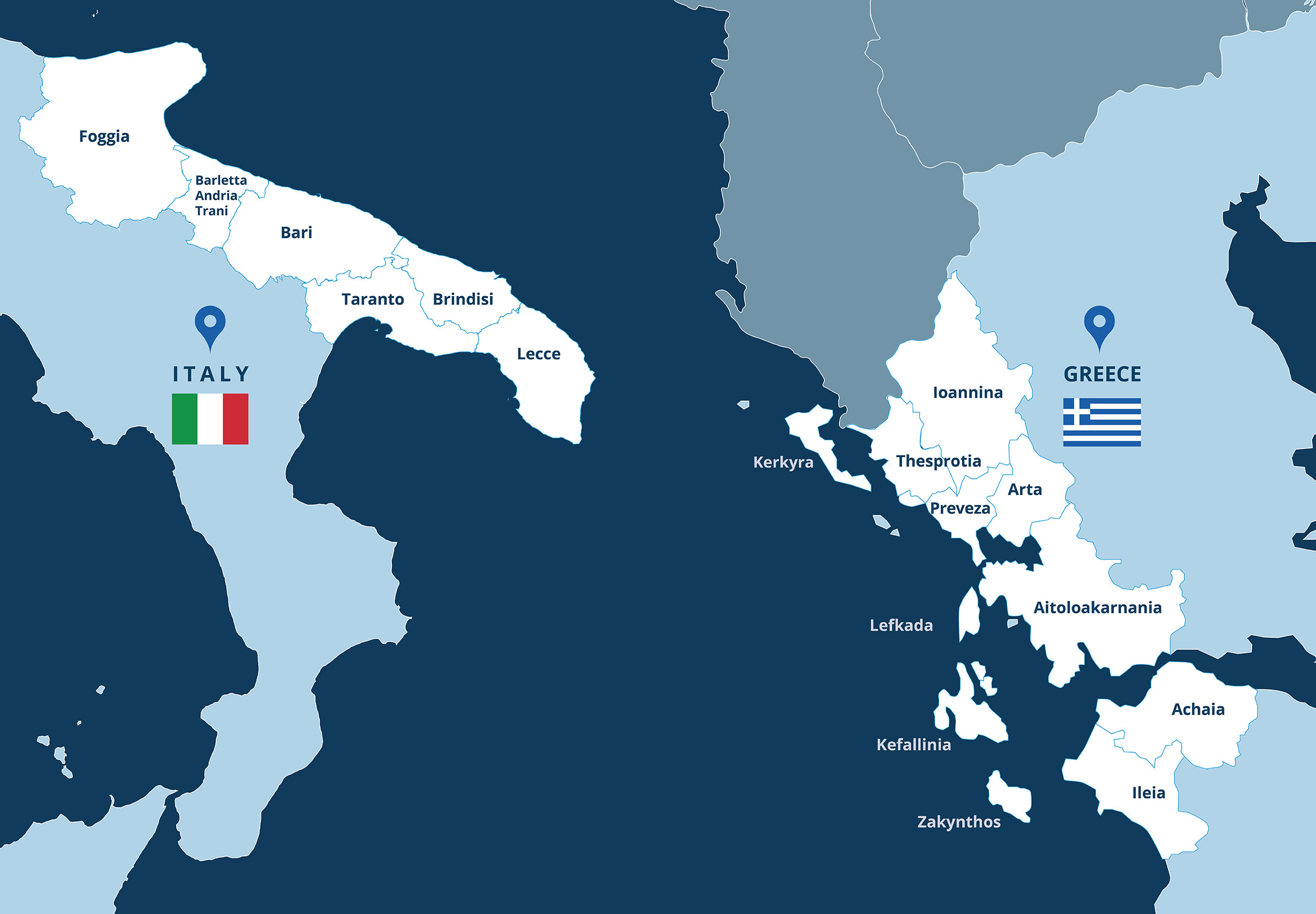What is
Interreg V-A Greece-Italy Programme?
Greece and Italy, two neighbouring countries with a rich and common past, have more than 25 years of cooperation experience, starting from 1990 until now.
Interreg V-A Greece-Italy Programme is a European Territorial Cooperation Programme that aims to help public institutions
Strategically, the programme will enhance innovation in a number of fields such as blue growth, tourism and culture, agro food and cultural and creative industries.
Interreg V-A Greece-Italy Programme aims to get maximum return from EUR 123 million financed per 85% by European Regional Development Fund (ERDF) and per 15% by the 2 member states Greece and Italy through a national co-financing.
Who do we help
Interreg V-A Greece-Italy Programme assists 3 types of beneficiaries:
Public authorities: national, regional and local
bodies governed by public law (as defined in Article 2(4) of Directive 2014/24/EU)
This kind of bodies must:
be financed, for the most part, by the national, regional or local authorities, or other bodies governed by public law
or be subject to management supervision by those bodies,
or have an administrative, managerial or supervisory board, more than half of whose members are appointed by the national, regional or local authorities, or by other bodies governed by public law
private organisations, non-profit organisations founded according to private law that respect the following conditions:
they are not established with the goal to obtain profit
they do not distribute profits to the shareholders
they operate for at least one year before the launch of the specific call for proposals
International organisations in compliance with
article 43 of EC Delegated Regulation no. 1268/2012.
Priority Axes
 PRIORITY AXIS 1
Innovation &
PRIORITY AXIS 1
Innovation &competitiveness
 PRIORITY AXIS 2
Integrated Environmental
PRIORITY AXIS 2
Integrated EnvironmentalManagement
 PRIORITY AXIS 3
Multimodal Sustainable
PRIORITY AXIS 3
Multimodal SustainableTransport System
Priority axis 1 Innovation and competitiveness
Innovation & Competitiveness aim to increase the capacity of Small and Medium Enterprises to engage in Reserch&Development activities that will lead to innovative products, processes and services with the final goal to contribute to the building of a strong export based economy and to strengthen specific growth sectors such as the blue growth, all activities having links with the sea and creative, cultural and agro-food industries.
Innovation and competitiveness is highlighted in the European Strategy 2020
Specific Objectives
- 1.1 Delivering innovation support services and developing clusters across borders to foster competitiveness
- 1.2 Supporting the incubation of innovative specialized micro and small enterprises in thematic sectors of interest to the Programme Area
Priority Axis 2 Integrated Environmental Management
The second Priority Axis aims to facilitate the development and implementation of common approaches to the management of the environment, supporting the valorisation of cultural and natural heritage and fostering shared potentials and responsibilities in the field of environmental protection and risk prevention.
The protection of natural environment and biodiversity, the promotion of cultural heritage in coherence with the development of sustainable tourism activities and the introduction of environmental friendly technologies to fight increasing pollution in the cross-border area, represent a joint challenge for the Greece-Italy Programme area.
Specific Objectives
- 2.1 Valorisation of cultural heritage and natural resources as a territorial asset of the Programme Area
- 2.2 Improvement of joint management and governance plans for biodiversity of coastal and rural ecosystems, paying attention on natural resources and protected areas and development of environmental protection measures
- 2.3 Developing and testing of innovative technologies/ tools to reduce marine and air pollution
Priority Axis 3 Multimodal Sustainable Transport System
The third Priority Axis aims to develop a sustainable transport system for regional and cross-border connections in the Programme Area, including inland waterways and maritime transport, ports, multimodal links and airport infrastructure.
The promotion of an efficient and environmental friendly mobility, including low noise and low-carbon transport, the accessibility to transport infrastructures, the coordination of cross-border transport systems and procedures and the integration with regional, national and cross border Transport Plans are the main objectives of this axis.
Download the Greece-Italy Objective Tree (add pdf file)Specific Objectives
- 3.1 Boosting maritime transport, shortsea shipping capacity and crossborder ferry connectivity
- 3.2 Improving cross-border coordination among transport stakeholders on introducing multimodal environmentallyfriendly solutions
The programme budget
The Programme has a total budget of 123,176,896 € and is co-financed by the European Regional Development Fund (ERDF) at a rate of 85% with an amount of 104,700,362 € and and by the 2 member states through a national co-financing at the rate of 15%, for the 2014-2020 period.

What are the Regions involved

Puglia Region:Province of Foggia, Bari, Brindisi, Lecce, Barletta-Andria-Trani (BAT), Taranto.
Region of Western Greece:Aitoloakarnania, Achaia, Ileia. Region of Ionian Islands:Zakynthos, Kerkyra, Kefalonia, Lefkada. Region of Epirus:Arta, Thesprotia, Ioannina, Preveza.